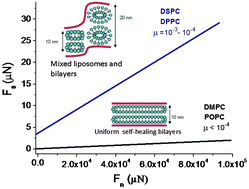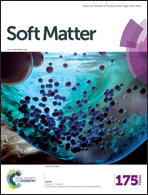Hydration lubrication and shear-induced self-healing of lipid bilayer boundary lubricants in phosphatidylcholine dispersions†
Abstract
Measurements of normal and shear (frictional) forces between mica surfaces across small unilamellar vesicle (SUV) dispersions of the phosphatidylcholine (PC) lipids DMPC (14 : 0), DPPC (16 : 0) and DSPC (18 : 0) and POPC (16 : 0, 18 : 1), at physiologically high pressures, are reported. We have previously studied the normal and shear forces between two opposing surfaces bearing PC vesicles across pure water and showed that liposome lubrication ability improved with increasing acyl chain length, and correlated strongly with the SUV structural integrity on the substrate surface (DSPC > DPPC > DMPC). In the current study, surprisingly, we discovered that this trend is reversed when the measurements are conducted in SUV dispersions, instead of pure water. In their corresponding SUV dispersion, DMPC SUVs ruptured and formed bilayers, which were able to provide reversible and reproducible lubrication with extremely low friction (μ < 10−4) up to pressures of 70–90 atm. Similarly, POPC SUVs also formed bilayers which exhibited low friction (μ < 10−4) up to pressures as high as 160 atm. DPPC and DSPC SUVs also provided good lubrication, but with slightly higher friction coefficients (μ = 10−3–10−4). We believe these differences originate from fast self-healing of the softer surface layers (which are in their liquid disordered phase, POPC, or close to it, DMPC), which renders the robustness of the DPPC or DSPC (both in their solid ordered phase) less important in these conditions. Under these circumstances, the enhanced hydration of the less densely packed POPC and DMPC surface layers is now believed to play an important role, and allows enhanced lubrication via the hydration lubrication mechanism. Our findings may have implications for the understanding of complex biological systems such us biolubrication of synovial joints.


 Please wait while we load your content...
Please wait while we load your content...